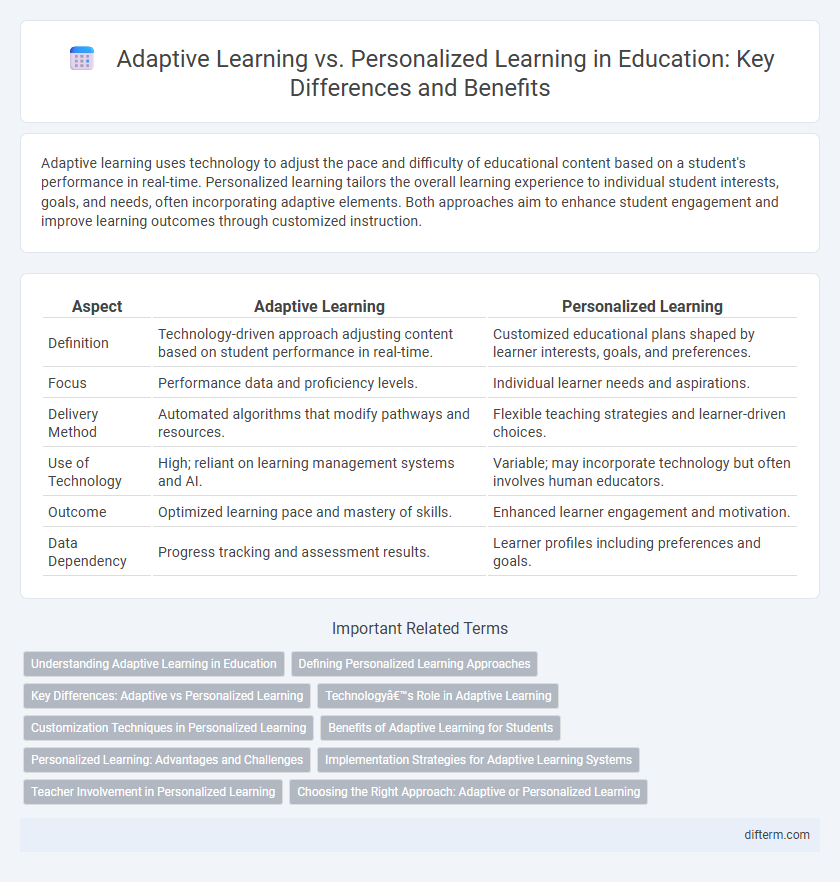Adaptive learning uses technology to adjust the pace and difficulty of educational content based on a student's performance in real-time. Personalized learning tailors the overall learning experience to individual student interests, goals, and needs, often incorporating adaptive elements. Both approaches aim to enhance student engagement and improve learning outcomes through customized instruction.
Table of Comparison
| Aspect | Adaptive Learning | Personalized Learning |
|---|---|---|
| Definition | Technology-driven approach adjusting content based on student performance in real-time. | Customized educational plans shaped by learner interests, goals, and preferences. |
| Focus | Performance data and proficiency levels. | Individual learner needs and aspirations. |
| Delivery Method | Automated algorithms that modify pathways and resources. | Flexible teaching strategies and learner-driven choices. |
| Use of Technology | High; reliant on learning management systems and AI. | Variable; may incorporate technology but often involves human educators. |
| Outcome | Optimized learning pace and mastery of skills. | Enhanced learner engagement and motivation. |
| Data Dependency | Progress tracking and assessment results. | Learner profiles including preferences and goals. |
Understanding Adaptive Learning in Education
Adaptive learning in education uses technology-driven algorithms to adjust instructional content based on real-time student performance data. This approach customizes the learning path dynamically, ensuring each student receives the appropriate level of challenge and support. Unlike personalized learning, which often involves human-guided customization, adaptive learning relies heavily on continuous data analysis to optimize educational outcomes.
Defining Personalized Learning Approaches
Personalized learning approaches tailor educational experiences to individual students' needs, preferences, and learning styles, using data-driven insights to customize content, pace, and assessment. Unlike adaptive learning, which primarily adjusts in real-time based on performance and interaction patterns, personalized learning integrates broader factors such as interests, goals, and socio-emotional development to create a holistic, student-centered environment. This approach enhances engagement and motivation by empowering learners with choices and fostering autonomy throughout the educational process.
Key Differences: Adaptive vs Personalized Learning
Adaptive learning adjusts content dynamically based on real-time student performance using algorithms and data analytics, while personalized learning involves tailored educational experiences aligned with individual learner preferences, goals, and interests. Adaptive systems emphasize automated feedback and curriculum modification to address immediate learning gaps, whereas personalized learning includes human input to customize teaching methods and pacing over time. The distinction centers on adaptive learning's data-driven responsiveness versus personalized learning's holistic customization of the entire learning journey.
Technology’s Role in Adaptive Learning
Technology plays a pivotal role in adaptive learning by leveraging data analytics and artificial intelligence to continuously assess students' performance and customize learning paths in real-time. This dynamic adjustment helps identify individual strengths and weaknesses more precisely than traditional personalized learning methods, which often rely on static profiles. Advanced algorithms enable adaptive systems to respond instantly to learners' needs, optimizing engagement and knowledge retention through tailored instructional content.
Customization Techniques in Personalized Learning
Customization techniques in personalized learning leverage data analytics, learner profiles, and real-time feedback to tailor educational content and pacing to individual student needs. These techniques include adaptive assessments, goal-setting frameworks, and customizable learning pathways that adjust based on performance and preferences. Unlike adaptive learning, which primarily modifies content dynamically, personalized learning incorporates a broader range of customization strategies to support holistic learner engagement and development.
Benefits of Adaptive Learning for Students
Adaptive learning leverages real-time data and algorithms to tailor educational content to each student's unique progress and comprehension level, enhancing engagement and retention. It provides immediate feedback and customized challenges, promoting mastery of concepts more efficiently than traditional methods. This flexible approach supports diverse learning styles and paces, ultimately improving academic performance and student confidence.
Personalized Learning: Advantages and Challenges
Personalized learning tailors educational experiences to individual student needs, preferences, and pace, promoting higher engagement and improved academic outcomes. It leverages data analytics and learner profiles to design customized content, enabling students to build mastery in specific skills or knowledge areas. Challenges include the requirement for robust technological infrastructure, teacher training, and maintaining scalability while ensuring equitable access for all learners.
Implementation Strategies for Adaptive Learning Systems
Effective implementation of adaptive learning systems requires integrating real-time data analytics to tailor educational content based on student performance and engagement metrics. Leveraging artificial intelligence algorithms can dynamically adjust difficulty levels and recommend resources, enhancing individualized learning paths. Collaboration with educators to align adaptive technologies with curriculum standards ensures seamless adoption and maximizes learning outcomes.
Teacher Involvement in Personalized Learning
Teacher involvement in personalized learning is crucial as educators design tailored instructional strategies based on students' individual profiles, interests, and progress metrics. Unlike adaptive learning systems that primarily rely on algorithms to adjust content in real-time, personalized learning requires active teacher assessment and intervention to foster deeper understanding and engagement. Educators continuously analyze formative assessments and behavioral data to refine learning pathways, ensuring each student's unique needs drive instructional decisions.
Choosing the Right Approach: Adaptive or Personalized Learning
Adaptive learning uses algorithms to adjust content in real-time based on student performance data, making it ideal for standardized skill mastery and efficient pacing. Personalized learning emphasizes individual student interests, goals, and learning styles through tailored instruction and flexible pathways, promoting deeper engagement and creativity. Selecting the right approach depends on curriculum goals, available technology, and whether the priority is immediate skill correction or holistic learner development.
adaptive learning vs personalized learning Infographic

 difterm.com
difterm.com